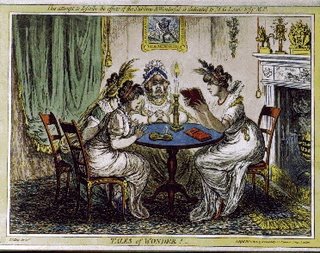Chapters 1 through 5 introduces us to our heroine, Catherine Moreland, and we follow her to Bath. Several other characters are introduced here, as well as many of the themes that run through the book.
Post your thoughts, likes, dislikes or anything about this section in the comments!

James Gillray, Tales of Wonder
3 comments:
I haven’t had much time to organize any thoughts on the introductory chapters, but I’ll take a stab at it anyway.
Austen’s introduction of Catherine Moreland seems to set the approach she takes for most of the book. Austen stresses everything Catherine isn’t, just as she highlights how the story doesn’t follow the typical plotline of a gothic novel. There were no boys of unknown origin raised near Catherine, there was no one to sweep Catherine off her feet at her first ball, etc.
Austen’s epigrams and word selection are probably only surpassed by Wilde (at least in my limited reading), but she is less gratuitous in their use. From Chapter 4: “Their joy on this meeting was very great, as well it might, since they had been contented to know nothing of each other for the last fifteen years.”
The use of gothic novels: In Chapter 5, Austen uses a gothic novel device of defending novels while she mocks it at the same time. The interesting part of this chapter (and the next) to me is that she has fictional characters reading and discussing real novels. There is a major echo from “Don Quixote” in the combination of mocking popular books of the day and the use of fictional characters reading known books.
At the same time, Austen has established the narrator as having limited insight at times and (as we’ll see later) is sometimes fallible. All this lends itself to a very common theme in the book (and in all of Austen’s books): what is real and what is imagined? This being her first novel, the technique of questioning what is perceived as reality is a little less smooth than she achieves in later books but still enjoyable to watch.
Jane Austen's novels captivate most readers due to the subtlety of her themes, and the rich irony of her technique.
Since a great deal of ultimate character motivation (both prudent and mercenary) can revolve around money, it is important to highlight the material conditions revealed in the narrative.(Austen almost always reveals financial information by accretion throughout the narrative.)
So, let us review the information Austen provides us in the early chapters.(1-5)
We are told that Mr. Morland "had a considerable independence besides two good livings." This means that Mr. Morland owns real or (more likely) financial assets (most likely consols) that provide him with sufficient income to be an independent gentleman. In addition, he has two livings, meaning he is a rector(and a pluralist having more than one living). There is no indication that Mrs. Moreland has had any capital settled upon her at marriage. We have no quantification for the Morland family estate at this time, but the estate income is obviously sufficient to afford ten children.
We are told that the Allens are the principle property owners in Fullerton. As a result, they are undoubtably "rich", and also have no children (as yet we know of no heir).
Mrs. Thorpe is revealed as being a "poor widow." Although she has two sons at school (Oxford and Merchants Taylor) and one son in the navy, there is no indication that Isabella or her two younger sisters have any capital settled upon them.
It is also helpful to understand currency values. There are 20 shillings in a pound. A guinea was worth 21 shillings; so guineas can be virtually synonymous with pounds.
One might like to recall that youthful Esther Summerson, when she joins with Rick to cover Skimpole's arreared debt early in Dicken's Bleak House, supplies Skimpole with 15 pounds, which represents her entire life savings. Catherine is given 10 guineas for her Bath visit.
With the last book, my problem was keeping up with the reading. This time I'm discovering that being caught up with the reading does not mean that I necessarily get to post in a timely manner.
My favorite part of this section was the chapter 5 defense of novels, and the scorn with which Austen treats authors who deride novels and novel readers even while they themselves are earning their bread through novel-writing. As a failed novelist myself, I always enjoy a little conjecture (even 180-year-old conjecture) on the minds of novelists and novel-writing.
This section was tough going for me, though. It didn't start to catch my interest until the 5th chapter. I can't stand insipid heroines, and Catherine is really quite a dishrag in the beginning.
Post a Comment